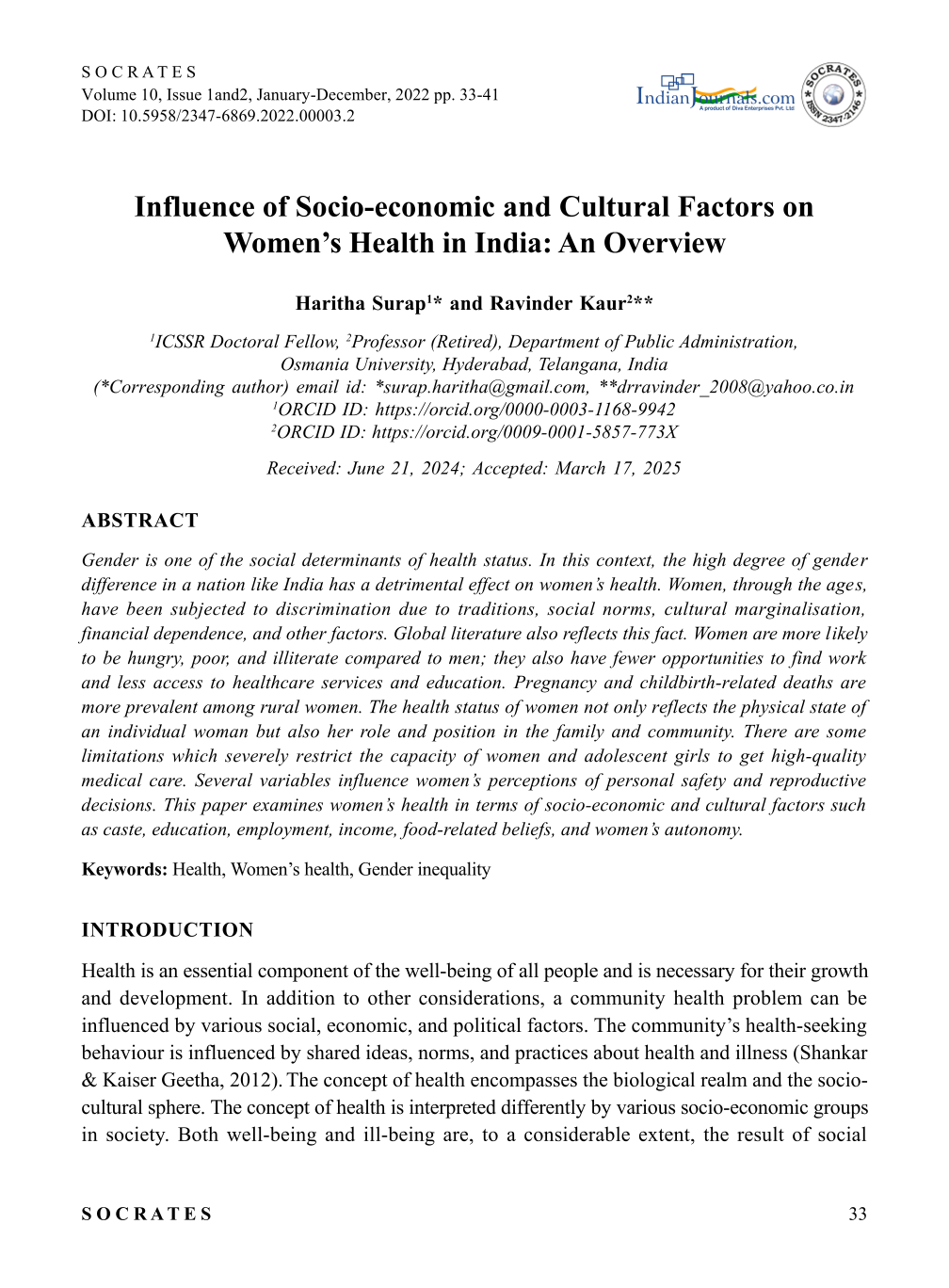Influence of Socio-economic and Cultural Factors on Women’s Health in India <b>An Overview</b>
Main Article Content
Abstract
Gender is one of the social determinants of health status. In this context, the high degree of gender difference in a nation like India has a detrimental effect on women's health. Women through ages have been subjected to discrimination due to traditions, social norms, cultural marginalisation, financial dependence, and other factors. Global literature also reflects this fact. Women are more likely to be hungry, poor, and illiterate compared to men; they also have less opportunities to find work, less access to healthcare services and education. Pregnancy and childbirth-related deaths are more prevalent among rural women. The health status of women not only reflects the physical state of an individual woman, but also her role and position in the family and community. There are some limitations which severely restrict the capacity of women and adolescent girls to get high-quality medical care. Women's perceptions of personal safety and reproductive decisions are influenced by a number of variables. This paper examines women’s health in relation to the influence of socio-economic and cultural factors such as caste, education, employment, income, food-related beliefs and women’s autonomy.
Downloads
Article Details
Section

This work is licensed under a Creative Commons Attribution-NonCommercial 4.0 International License.
Attribution-NonCommercial 4.0 International (CC BY-NC 4.0)

How to Cite
References
Bandyopadyay, M., & MacPherson, S. (1998). Women and Health: Tradition and Culture in Rural India. 1st ed. Routledge.
Blas, E., Gilson, L., Kelly, M. P., Labonté, R., Lapitan, J., Muntaner, C., et al. (2008). Addressing social
determinants of health inequities: what can the state and civil society do? The Lancet, 372(9650). 1684–1689.
Bloom, S. S., Wypij, D., & Gupta M. D. (2001). Dimensions of women’s autonomy and the influence on maternal health care utilisation in a north Indian city. Demography (2001), 38(1), 67–78. doi: 10.2307/3088289.
Chandani Liyanage. (2010). A paradigm for well-being, The Social Construction of Health in Rural Sri Lanka. In Arima Mishra (Ed.). Health Illness and Medicine, Ethnographic Readings (p. 255). New Delhi. Orient Blackswan Private Limited.
Devakumari, V., & Venkateshwar Rao, S. (2014). Gender Discrimination and Women’s Development. In K. Manjula Devi. Gender Issues, Empowerment of Women (pp. 474-477). New Delhi. Serials Publications.
Ganiger Sunitha. (2012). Women Health Care and Education in Rural India through An innovative Cultural Competency Model: A Sociological Analysis. Golden Research Thought, 1, 1-4.
IIPS. (2007). ORC-Macro. National Family Health Survey (NFHS-3), 2005–2006: India. Mumbai. International Institute for Population Science.
Jyothi, S. (2014). Women’s Health and The Role of Environment. In K. Manjula Devi. Gender Issues, Empowerment of Women (p. 406). New Delhi. Serials Publications.
Konduru, D., & Kundargi, R. G. (2019). A brief analysis of food practices and taboos on women’s health in Andhra Pradesh, India. The International Journal of Community Medicine and Public Health, 6, 5088-94.
Manuja Devi, K. (2014). Female Health Status in India. In K. Manjula Devi. Gender Issues, Empowerment of Women (p. 277). New Delhi. Serials Publications.
Marphatia, A. A., Ambale, G. S., & Reid, A. M. (2017). Women’s Marriage Age Matters for Public Health: A Review of the Broader Health and Social Implications in South Asia. Frontiers in Public Health, 5, 269. doi: 10.3389/fpubh.2017.00269.
Mishra, Prem Shankar et al. (2021). Impact of socioeconomic inequity in access to maternal health benefits in India: Evidence from Janani Suraksha Yojana using NFHS data. PloS One, 16, 3 e0247935. doi:10.1371/journal.pone.0247935.
Mondal, Dinabandhu et al. (2020). Women’s autonomy and utilisation of maternal healthcare in India:
Evidence from a recent national survey. PloS One, 15, 12 e0243553. doi:10.1371/journal.pone.0243553 Moni Nag. (1994). Beliefs and Practices about Food during Pregnancy: Implications for Maternal Nutrition. Economic and Political Weekly, 29, 37, 2427-2438.
Pandya, Yogita, P., & Dinesh, J., Bhanderi. (2015). An Epidemiological Study of Child Marriages in a Rural Community of Gujarat. Indian journal of community medicine: official publication of Indian Association of Preventive & Social Medicine, 40(4), 246-51. doi:10.4103/0970-0218.164392.
Reema Bhatia (2010). Situating Declining Sex Ratio, Evidence from north India. In Arima Mishra (Ed.).
Health Illness and Medicine, Ethnographic Readings (pp. 159-160). New Delhi. Orient Blackswan Private Limited.
Roy, T. K., Sumati Kulkarni & Vaidehi, Y. (2004). Social Inequality in Health and Nutrition in Selected States. Economic and Political Weekly, XXXIX(7), 677-683.
Sanneving, L., Trygg, N., Saxena, D., Mavalankar, D., & Thomsen, S. (2013). Inequity in India: the case of maternal and reproductive health. Global Health Action, 6(1), 19145. 1–31. pmid:23561028.
Shankar, R., & Kaiser Geetha, V. (2012). Health and Nutritional Status of Tribes in India. In S.N. Chaudhary (Ed.). Tribal Health and Nutrition (pp.41-42 & pp. 55-56). New Delhi. Rawat Publications.
Tripathy, S. N. (2012). Disparity in Health Services with Reference to Tribes of Madhya Pradesh. In S.N.
Chaudhary (Ed.). Tribal Health and Nutrition (pp. 98-99). New Delhi. Rawat Publications.
Upadhyay Ravi Kant. (2018). Major Issues Related to Women Health Social Cultural and Economic
Development. Interventions in Gynaecology and Women’s Healthcare. https://doi.org/10.32474/IGWHC.2018.02.000150.
Vanisree, A., Sukumari, B., & Shailaja Jhansi (2014). Status of Rural Women – Empowerment: A Village study. In K. Manjula Devi. Gender Issues, Empowerment of Women (p. 244). New Delhi. Serials Publications.
World Health Organization. (2010). A conceptual framework for action on the social determinants of health. World Health Organization. https://apps.who.int/iris/handle/10665/44489
Zodpey, S., & Negandhi, P. (2020). Inequality in health and social status for women in India – A longstanding bane. Indian Journal of Public Health, 64, 325-327.

